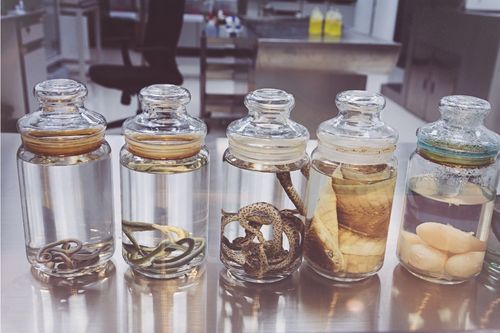Table of Contents
Snakes (Ophidia or Serpentes sub-order) are the most fascinating because they appear to have adapted to living underground during the dinosaur era. In fact, they have lost the normal way of focusing the lens of the eye (deformation of the lens), and instead they focus by moving the lens, which tells a story of the beginning of the process of losing eyes but having to adapt to an above ground existence. Although it is likely that modern snakes are habitat specialists, it is debatable whether their ancestors were terrestrial burrowers or marine swimmers.
What is Ophiology?

a branch of herpetology concerned with the study of snakes. Serpentologists include people who are involved in the study of snakes. Many scientists are captivated by this group of organisms because they are so fascinating and intriguing with many characteristics.
Snakes typically prefer to flee when approached, but if threatened, they may turn aggressive. The majority of snake bites occur when a person tries to kill or capture a snake.
Feeding Habits of snake
Snakes have a diversified feeding habit based on their size and characteristics which include Onychophorans, fish eggs, centipedes, cormorants, and porcupines to name a few. Many species regularly consume single items weighing 20% of their own mass, and some venomous species occasionally subdue and eat prey that exceeds their own mass by as much as 50%.
The amount of food a snake will eat during each feeding will depend on his age, size, and species. Snakes don’t typically eat. Although some snakes can survive longer, they normally only eat once every week or two weeks. Larger, older snakes may go for weeks without eating, whereas smaller, younger snakes may only eat twice each week.
Snake Venom

Snake venom is a very toxic saliva that contains zootoxins to help with prey digestion and immobilization. Additionally, this offers threat defense. When a snake bites, its distinctive fangs inject venom; nevertheless, some species can also spit venom.
The pharmacological effects of snake venoms are classified into three main types:
- Hemotoxic
- Neurotoxic
- Cytotoxic
Effect of Venom on Human:
Venom is capable of destroying the capillary vessel’s outer membrane, leading to internal bleeding. In some circumstances, they can also cause blood clots to form around the circulatory system by activating the blood clotting mechanism. These have the power to clog blood vessels and cause a heart attack or stroke.
Parasites of snakes
As many internal diseases have similar clinical indications, parasitological research on domestic snakes is an important diagnostic tool in the veterinary field. Numerous internal non-infectious disorders can be distinguished from parasitosis with the help of adjustments to our current diagnostic techniques, or breeding conditions can be detected to require the use of the proper corrective treatments. When domestic snakes were examined, it was discovered that some of them carried oxirid eggs. In a study on this discovery, investigational techniques, parasitosis information, and treatment guidelines were presented, along with comments on the significance of oxyuridosis in serpents.
Key takeaway
- Ophiology is the medical specialty concerned with the study of snakes and its characteristics
- Feeding Habits of snake is diversified and specific to its size.
- Snake venom is highly toxic which when comes in contact with human can destroy membranes and can lead to internal bleeding
Did you find this blog informative? If so, please share your thoughts in the comments below Click here to contact us for more information on the study of kidneys. We would be happy to assist you with your queries.
Liked this blog? Read next: Study of teeth their types, applications, and much more.
FAQs
Q1. What do you do if a snake bites?
Answer- If you or someone you know are bitten, try to see and remember the color and shape of the snake, which can help with treatment of the snake bite.
- Keep the bitten person still and calm. This can slow down the spread of venom if the snake is venomous.
- Seek medical attention as soon as possible.
- Dial 911 or call local Emergency Medical Services (EMS).
- Apply first aid if you cannot get the person to the hospital right away.
- Lay or sit the person down with the bite below the level of the heart.
- Tell him/her to stay calm and still.
- Wash the wound with warm soapy water immediately.
- Cover the bite with a clean, dry dressing.
Q2. What are signs of snake bite?
Answer- Depending on the type of snake, the signs and symptoms may include:
- A pair of puncture marks at the wound
- Redness and swelling around the bite
- Severe pain at the site of the bite
- Nausea and vomiting
- Laboured breathing (in extreme cases, breathing may stop altogether)
- Disturbed vision
- Increased salivation and sweating
- Numbness or tingling around your face and/or limbs
Q3. How to identify if a snake is poisonous?
Answer-
Size of the pupil: . A venomous snake will typically have elliptical pupils like a cat while non-venomous snakes will have rounded pupils.
While most snakes have a triangular head, venomous snakes will have a more bulging look to them, especially along their jaws, because of their venomous sacks. Harmless snakes will have a skinnier head because of their lack of venomous sacks.
Generally, the more colourful and patterned a snake is, the more dangerous it is. Most solid coloured snakes are relatively harmless; though there are always exceptions to this rule.






